- Author: Help Desk Team
Are you noticing that the leaves on your citrus trees are looking yellow, and wondering if now is the time to fertilize? We have some answers for you.
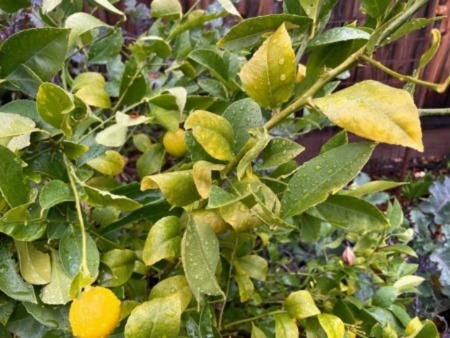
Should You Fertilize Now?
First of all, don't be too worried about the yellow leaves. The yellowing, especially the yellowing of the leaf veins, is related to a lack of nitrogen. Citrus leaves are frequently yellow in the winter due to the trees' inability to take up nitrogen in cold weather. But now, as the days get longer and the soil begins to warm, the trees are getting ready to pick up nitrogen from the soil which means we are getting closer to the start of the citrus tree fertilization process.
Citrus trees are typically fertilized at three points in the year. The first is in January or February just before the trees begin to bloom. Exactly when will depend on your microclimate and the trees' readiness. Given the climate differences In Contra Costa County, in west county, you may need to apply the first fertilizer in late January, while the trees in central and east county may not be ready until mid- to late-February.
The next application time is in May, with a third application in June if necessary. And that is it for the season. Avoid fertilizing any later in the year, since late-season fertilization can have adverse effects on the fruits, including reduced fruit quality, delayed fruit coloring, and rough rinds. Late-season fertilization can also cause off-season growth making the trees more susceptible to diseases, disorders, and pests. Frost damage and leaf miner infestations are two common problems with late-season fertilization.
What Kind of Fertilizer Should You Apply?
Nitrogen is the main nutrient that you need to provide. Contra Costa soils are typically deficient in nitrogen and citrus trees are heavy nitrogen users. There are many sources of nitrogen. An easy choice for the home gardener is an organic citrus fertilizer. Fertilizers are labeled with three numbers on the front of the package, indicating percentages of N (nitrogen), P (phosphorous) and K (potassium). Look for a fertilizer where the first number (nitrogen) is the highest of the three, e.g., 7-3-3.
Citrus can also suffer from micronutrient deficiencies including zinc or iron. Most organic fertilizers contain these micronutrients, but if the leaves on your citrus have yellow patches between green veins you may need to correct these deficiencies by applying a foliar application of a liquid chelated micronutrient solution as the new growth emerges in the spring.
You can check here on the signs of different nutrient deficiencies to get an idea of what you are dealing with: https://ipm.ucanr.edu/PMG/C107/m107bpleaftwigdis.html
No matter which product you are applying, make sure that you carefully follow all label directions on the amounts and timing of the fertilizer application. Avoid over fertilizing which can cause excessive new growth, making the trees susceptible to other disorders such as bacterial blast.
Micronutrient deficiencies can also occur if the soil is too acidic or too alkaline. Citrus trees can tolerate a pH in the range of 6.0-7.5, with 6.5 being optimum. Contra Costa soils tend to be on the higher, alkaline side. If you have taken the actions above and are still not seeing the results you want, a soil pH test may be your next step. You can use an off-the-shelf home soil test kit or send a soil sample to a commercial soil test company.
How Should You Apply the Fertilizer?
The fertilizer should be scattered evenly on the soil under the tree's canopy. Make sure that you distribute the fertilizer at least as far out as the drip line. Avoid the area near the trunk. Lightly scratch the fertilizer into the surface of the soil and then irrigate.
For more information on citrus fertilization, including guidelines on the amount of nitrogen needed based on the age of the tree, see: https://ipm.ucanr.edu/PMG/GARDEN/FRUIT/CULTURAL/citfertilization.html
For a full set of tips on growing citrus, see: http://ipm.ucanr.edu/PMG/GARDEN/FRUIT/citrus.html
We wish you the best with your citrus trees. Proper fertilization and care should provide you with healthy trees and tasty fruit.
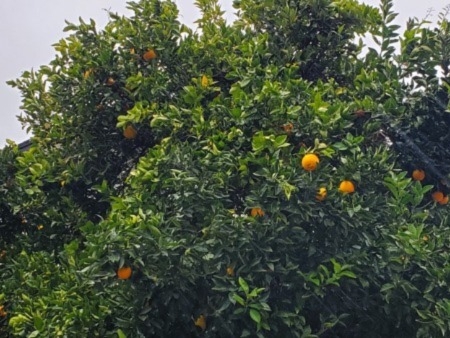
Help Desk of the UC Master Gardener Program of Contra Costa County (ECS)
Advice from the Help Desk of the
UC Master Gardener Program of Contra Costa County
Subject: More Summer Tomato problems as well as Crop Rotation and Fertilization
Client brought tomatoes from her garden with “production problems” to the Help Desk.
Response from the Help Desk: Thank you for bringing your tomato plant samples to the UC Master Gardener Program Help Desk office. You mentioned that you have been planting tomatoes in the same area for a number of years and have not had problems before this year. We found 3 different conditions in your samples that could explain why your plants are not thriving.
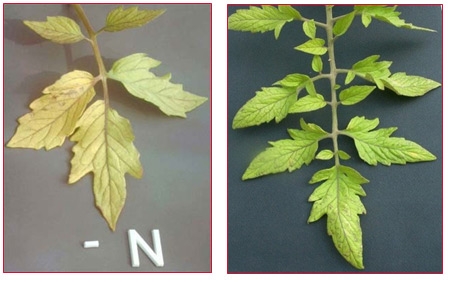
pix: HaifaGroup
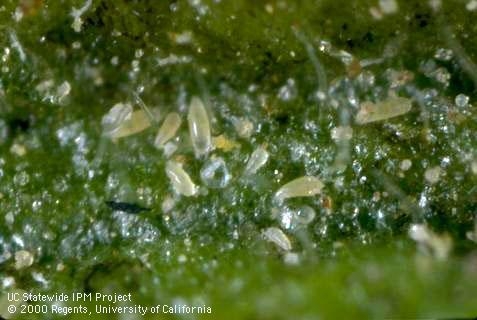
pix: UCANR
place year after year can favor a build up of this pest. The pest can also persist in petunias, morning glory, and other plants in the tomato family like potato, peppers and eggplant. We recommend that you remove the infested plants, all fallen leaves and weeds in the area, and put them in your green waste container (not in a compost pile). This will reduce the potential that russet mites will still be in your yard next year.
Additional information on the russet mites can be found here http://ipm.ucanr.edu/PMG/GARDEN/VEGES/PESTS/tomrusmite.html.
Sulfur dusts can be used to reduce an infestation of russet mites but will not help if the pest has already killed most of the plant. If you do decide to try a treatment anyway, safety warnings applicable to the use of sulfur include wearing eye protection, long pants and long sleeves, and a hat, and avoiding contact with eyes and skin. Additional information on sulfur is here http://ipm.ucanr.edu/TOOLS/PNAI/pnaishow.php?id=67 .

pix: Ohio Stat Univ
Finally, we strongly recommend that you not plant tomatoes or other plants in the tomato family listed above in the same area more than 2 years in a row. Rotating your vegetables will help reduce the pests and diseases that you have been experiencing this year. You may also be interested in a good overall UC reference on growing tomatoes in the home garden that can be found (free) at http://ucce.ucdavis.edu/files/repositoryfiles/8159-54222.pdf
Please feel free to contact us again if you have additional problems with your garden.
Help Desk of the UC Master Gardener Program of Contra Costa County (JL)
Note: The UC Master Gardeners Program of Contra Costa's Help Desk is available year-round to answer your gardening questions. Except for a few holidays, we're open every week, Monday through Thursday for walk-ins from 9:00 am to Noon at 75 Santa Barbara Road, 2d Floor, Pleasant Hill, CA 94523. We can also be reached via telephone: (925) 646-6586, email: ccmg@ucanr.edu, or on the web at http://ccmg.ucanr.edu/Ask_Us/ MGCC Blogs can be found at http://ccmg.ucanr.edu/HortCoCo/ You can also subscribe to the Blog (http://ucanr.edu/blogs/CCMGBlog/).
Advice from the Help Desk of the
UC Master Gardener Program of Contra Costa County
Client: I wondering if you could help identify the issue with some of the leaves on my Lisbon lemon tree? I typically water once a week and not again until it dries out.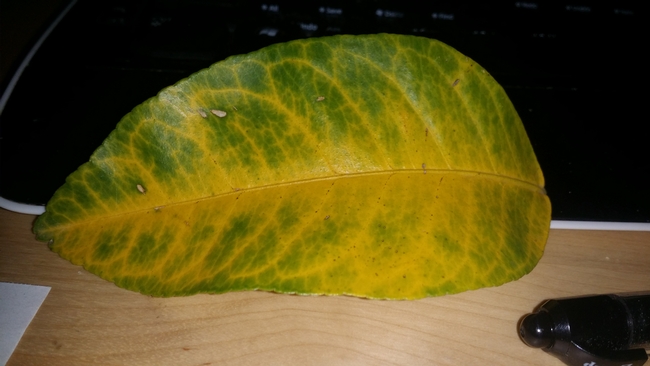
picture from client
MGCC Help Desk Response: Thank you for contacting the UC Master Gardener Program Help Desk with your question about your lemon tree. Thank you for the photograph which was very helpful.
The vein yellowing evident in the photograph you sent could be due to several factors:
- There is a virus that can cause vein yellowing, but it is not common in our area, and so is probably not the cause.
- Herbicide toxicity can cause this type of symptom. If you have used an herbicide containing either diuron or bromacil, that could be the cause. If you have not used herbicides, then the cause is probably nitrogen deficiency.
- Although nitrogen deficiency symptoms usually present as more general yellowing rather than prominent vein yellowing, nitrogen deficiency can cause vein yellowing when the soil is cold (usually during the winter months), or if stems or the trunk are girdled (mechanically constricted). If there are any ties around your tree, you should remove them.
Lemon trees need regular fertilization, particularly with nitrogen, to remain healthy and productive. If you have not fertilized your tree this spring, we recommend that you do so now. You can either use ammonium sulfate or a standard citrus fertilizer. Information on proper nitrogen fertilization of citrus, based on the age of the tree, can be found at this University of California website http://ipm.ucdavis.edu/PMG/GARDEN/FRUIT/CULTURAL/citfertilization.html.Or you can just follow the directions on the fertilizer label.
Citrus has many roots near the soil surface. Lemon tree roots should not be disturbed by digging or cultivating, since damaged roots will negatively impact water and nutrient absorption. At least several inches of mulch under the entire tree is usually also recommended to protect the roots, keep the roots cool, retain Irrigation moisture, and minimize competing weeds. Keep the mulch at least 6” from the trunk.
.
Citrus should be watered every 7 - 10 days during the dry season. Additional information on how to water citrus can be found (and/or downloaded free) at the University of California's website http://ipm.ucdavis.edu/PMG/GARDEN/FRUIT/CULTURAL/citruswatering.html .
I hope that this information is helpful. If you water and fertilize the lemon tree properly but the leaves do not green up with 4 weeks, please feel free to contact us again.
Help Desk of the UC Master Gardener Program of Contra Costa County (JL)
Note: The UC Master Gardeners Program of Contra Costa's Help Desk is available year-round to answer your gardening questions. Except for a few holidays, we're open every week, Monday through Thursday for walk-ins from 9:00 am to Noon at 75 Santa Barbara Road, 2d Floor, Pleasant Hill, CA 94523. We can also be reached via telephone: (925) 646-6586, email: ccmg@ucanr.edu, or on the web at http://ccmg.ucanr.edu/Ask_Us/ MGCC Blogs can be found at http://ccmg.ucanr.edu/HortCoCo/ You can also subscribe to the Blog (http://ucanr.edu/blogs/CCMGBlog/).

